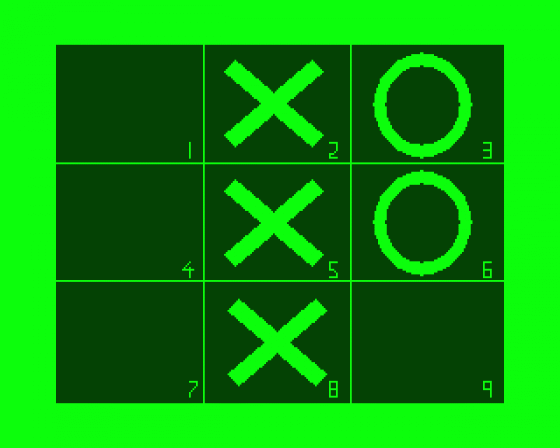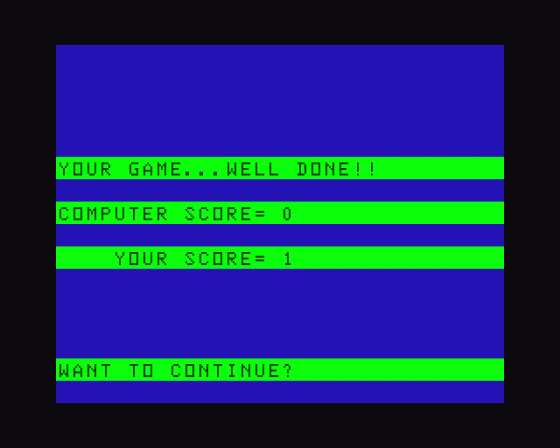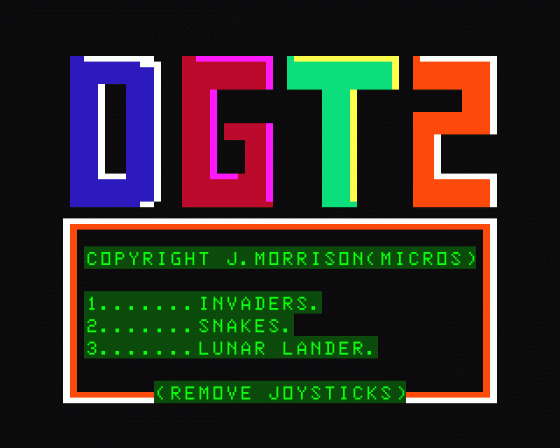
Popular Computing Weekly
 13th June 1985
13th June 1985
Keith and Steven Brain look at a selection of software now available for the Dragon
Dragon Fun
Father Christmas arrived early, when a parcel of Dragon 32 software arrived for review on Christmas Eve!
As usual, the standard of the packaging and instructions varied widely. Fighting off our desire to get straight into battle with the Klingon Empire, we started with those cassettes offering a number of short programs (Dragon Games 1 and 2, Dragon Fun And Games, Dragon 32 Cassette One and Games Pack One). Four of these cassettes contained Basic programs, but Dragon Games 2 was in machine code and we therefore considered it separately.
Dragon Fun And Games (Shards)
The best of the other four tapes is Dragon Fun And Games from Shards Software. The programs are user-friendly, with detailed instructions at the start and extensive use of the Dragon hi-resolution and sound capabilities. Noughts is the old favourite, noughts and crosses, on two levels. Our only complaint is that on level one you cannot lose, but on level two you do not seem to be able to win. Brain is a text-only, word-guessing game, of the Mastermind type.
Gold uses a joystick to manoeuvre through a minefield to recover bags of gold. It is quite difficult to avoid the mines - gold can only be collected if you are centrally above it. Snap is a computer version of the old card game, with nice hi-res displays of the cards. Anagrams requires you to solve anagrams of five town names, which are chosen at random from a large selection. If you are stuck, there is a neat shuffling routine which rearranges the letters continuously for you.
Donkey is a clever implementation of the children's party game, but in the case the tail is moved with a joystick (while blindfolded of course). You are guided by a rising tone towards the correct position. Very nice graphics - even horse-mad sister Katherine appreciated this one.

Dice is a poker-dice type game with good use of low-res graphics. Circles fills the screen with lettered circles of different sizes and requires you to pair them up = a lot more difficult than you think, especially at Christmas.
Artist is rather an abstract name for a program which randomly generates "art" according to your general instructions, and then has the nerve to let the computer judge your masterpiece!
Musical is a clever update of musical chairs, which plays a music cassette via the motor on/off function. Further features are a changing coloured display and the option of letting the computer keep track of who is left in the game. A great hit.
Altogether a series of well thought-out programs made better by professional presentation and full use of the Dragon's facilities.
Games Pack One (Gem Software)
In the middle of the road in this category come Games Pack One from Gem Software, and Dragon Games One from J. C. Morrison. Games Pack One seems rather expensive at £7.95 for four games, but we noted that the individual authors are credited and suspect that the royalties have to stretch a long way.
Space Wars, from Games Pack One, is very simple and slow and the hi-res display is lost during movement. Sheepdog is much better, with a continuous hi-res display of Lassie and her three sheep which must be herded into a pen. This is quite addictive, if rather difficult, as the dog has a mind of its own and does not always do what you expect. A pity that the dog cannot bark - a display of elapsed time would also add interest.
Torpedo is a good game which puts you at the periscope of a submarine, ready to fire at passing ships. Good use of sound and graphics, especially when you manage to hit a ship!
Snake is well presented, using low-res graphics, sound and a joystick. The object is to collect food, which appears at random, without eating yourself or hitting the walls. It starts off easily, but as you grow it becomes more and more difficult for you to manoeuvre.
Dragon Games One (J C Morrison)
Dragon Games One offers five games for £5.75, four of which are old favourites (Othello, Breakout, Awari and Moonlander). The programs tend to assume the user already knows how to play - more instructions would be helpful.
A nice point in Othello is the query whether a black and white TV is in use, in which case the display is altered to make the pieces more visible. Lander uses low-res graphics and is quite simple, but not bad for a Basic version.
Best game on this cassette is Raffles, in which you must find objects in a dark room without being detected. Very difficult to escape if the dog wakes up!
Cassette One (Video Productions)
Video Productions' Cassette One gets the booby prize, perhaps the best part of this cassette being the Index program at the start which continuously scrolls the instructions. Earth Defence is a very basic Space Invaders-type program. Bars, Crosshatch, Swpshp, Moire, Circles, Circol and Spiral are all simple pattern generators which could easily have been incorporated into a single program. It seems rather cheeky to call Swpshp a program when it consists of six lines, three of which are a copyright (!!!) statement, one clears the screen, and the other two could easily fit in a single line (which looks very familiar to us anyway).
Titles is only a labelling subroutine, which crashes if you input more than 32 characters. Visibubble demonstrates simple sorting, but does not explain what is happening. To describe Musical Keyboard as an organ is a gross explanation as it is very limited, not to mention tone deaf.
The rest of the cassette contains utility programs. Photo calculates depth of field, but a pocket calculator would be just as useful, and a lot easier to carry. Motoring Costs may be useful, or at least frightening, but Tachograph is really only a demonstration. Reactance is a very specialised program for calculating component values for filter circuits and seems out of place. The Surprise program at the end is a vast disappointment, merely displaying the company name ad infinitum in large coloured letters - perhaps in an attempt to indoctrinate the user.
Cassette One has recently dropped from £4.95 to £3.95, but even at that price you would do better looking at readers' programs in computer magazines.
Dragon Games Two (J C Morrison)
Dragon Games Two is in a different class altogether. All three programs on the cassette are in machine code. They are of arcade standard, very fast, with excellent graphics and sound, and very addictive. Any single one of these is worth a fiver, so £6.95 for all three is a bargain.
Snakes must be killed by shooting them in the head before they catch you, but if you miss your programs multiply very fast. We found difficulty getting this program off the computer. Little brother Nicholas (8) has one complaint - if you kill more than 666 snakes in one go, the counter resets to zero, so no-one will believe how good you are (but at least it took him an hour or so to reach that score).
Lander looks simple but is actually very difficult, with excellent explosions coming via direct access to the SAM ship. Invaders has everything you could want, including, we discovered, a way of cheating to impress your friends (try moving left off the screen before you first shoot and you will find you have developed immunity to alien fire).
These programs are loaded by CLOADM and started by EXEC 7700, so they cannot be stopped or copied. This was one of the few cassettes we had no problem loading, but we trust that tape corruption will not occur to spoil our enjoyment.
Taipan (Jaysoft)
Moving on to adventure-type games, Taipan is a version of the common trading theme which puts you in the China Sea. The basis of the program is OK, and even has some educational value, but it suffers greatly by comparison with the others as it is text only. We noted that ZX81 and Spectrum versions are also available, and assume that this is why graphics have been avoided. On the other hand, at only £4.95 it is not expensive and there is no reason why you could not dress it up with some of your own graphics. Sum Yam the moneylender is supposed to be the bad guy, but to us he seemed more like the listening bank.
Goblin Caves (Apex)
Goblin Caves introduces a hi-res graphics display of caves into the adventure, but the actual program possibilities are limited. All of the caves look much the same, except that the colour changes sometimes, and your nasty end is signalled only by a text message and some noise. Again, you cannot expect too much for £4.95, but we feel most users would be happy to pay a little more for something more substantial.
We were also worried by the great difficulty we had in loading this program. Not only were there numerous I/O errors but also, when loading appeared to have been successful, minor bugs in the program appeared, presumably due to data corruption. We may have been unlucky with our tape, but we would advise readers to check on loading before buying.
Dragon Trek (Salamander)
Dragon Trek, contained in a neat, custom-made, plastic box and with a detailed 16-page flight manual, was the best presented package we reviewed. It requires one joystick, and also keyboard entries. The manual warns you that this is a real-time program - so tea-breaks are at your peril.
The game is rapid, with excellent use of two alternative hi-res displays. It offers many different skill levels, with a range of possible decisions at each point in the game. For example, how much energy should you put in your shields, and is a low-energy (but slow) photon torpedo a better bet than energy-expensive phaser fire?
As well as the Klingon menace, there are super-novae and black holes to avoid, and you must ensure that you reserve enough energy to get back to a starbase to refuel. The damage report is an excellent feature, especially as your main display malfunctions if the computer is damaged. Better death than surrender, unless you fancy being demoted to the USS Faerie Queen. Altogether a first-class package. At £9.95 it is a little expensive, but still highly recommended.
Demon (Compusense)
The last item was something completely different, the Demon Machine Language Monitor cartridge from Compusense. This allows you to gain control of the system, and eventually write and debug your own 6809 machine code programs. It is compatible with Basic and, in addition to the cartridge area, only occupies memory 0600-0800 (for the Demon video display) and 0800-0900 (for Demon reserved locations).
It has twelve commands which allow you to examine and change memory, examine and change CPU registers, set breakpoints and run programs. A number of useful subroutines within Demon can also be incorporated into your own programs. A 16-page manual, and a Motorola 6809 instruction set summary are included.
Although a few examples are included in the manual, the novice needs a lot more information before being able to use machine code. The monitor was easy to use and is a useful tool for those who have conquered Basic and want to move on to the heights (or is it depths?) of machine-language programming. It has the advantages over tape-based monitors of using minimal memory and being instantly available, and is reasonably priced at £18.40.
Summary
Our general impression of this sample of independent software is that some excellent material for the Dragon is becoming available, but that the user must ensure he is not buying a pig in a poke.
Scores
(Dragon 32)
(Dragon 32)
(Dragon 32)
(Dragon 32)










